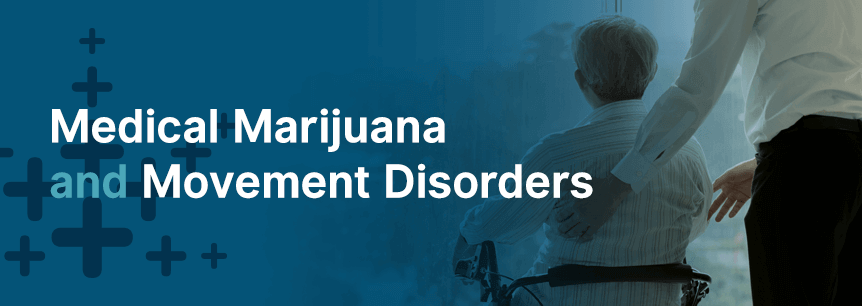
Movement disorders are among the many debilitating conditions that marijuana and its cannabinoids could be particularly helpful for. Cannabis sativa dates back over two millennia as a medicinal plant. When you have a movement disorder, you could be suffering from shaking, tremors, muscle aches and pain, and other symptoms marijuana can help treat. Learn more about movement disorders, their symptoms and how medical marijuana and movement disorders treatment can provide you with relief.
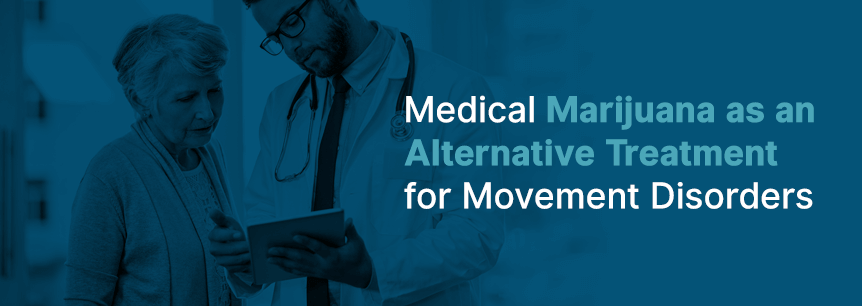
Researchers started showing interest in studying marijuana about movement disorders, like Parkinson’s disease, after individuals with the condition provided anecdotal reports and put up posts on social media about how the herb helps reduce their tremors. Some researchers believe marijuana could be neuroprotective — saving brain cells from damage PD causes.
You have an endocannabinoid system in your brain that consists of cannabinoid receptors linked to neurons (brain cells) responsible for regulating some body functions and thinking.
Medical marijuana for movement disorders contains a lot of neuroactive chemicals that act on the CB1 receptors found in the brain and CB2 receptors also found in the brain and peripheral immune system. Cannabinoids have indirect, powerful effects on both the CB1 and CB2 receptors, but researchers aren’t quite sure how. Individuals with Parkinson’s disease have less CB1 receptors than individuals without the disease. A CB1 receptor boost through an agonist such as cannabis might be able to alleviate dyskinesia and improve tremors.
Marijuana contains many neuroactive chemicals that work with two types of cannabinoid receptors, type 1 (CB1) located in the brain and type 2 (CB2) located in the brain and peripheral immune system. Cannabinoids have powerful, indirect effects on these receptors, but researchers are unsure how.
Marijuana and movement disorders treatment could be a great addition or alternative to medicine regime of individuals suffering from PD or another type of movement disorder. Sadly, a lot of the conventional medicines doctors prescribe to PD patients also come with substantial, negative side effects that aren’t present in medical weed. Cannabis offers a combination of antioxidant, anti-anxiety and pain relief all in a single medicine.

Here are three symptoms of movement disorders medical pot can help treat.
Tremors often increase with stress — therefore, treatments designed for enhancing relaxation could make them better. Since medical cannabis promotes enhanced relaxation, causes euphoric mood and mitigates the stress response, it could also decrease patients’ tremors.
Try these strains to decrease your tremors:
Studies on tetrahydrocannabinol (THC), one of marijuana’s primary cannabinoids, show that it has helped improve spasticity in patients with multiple sclerosis. The endocannabinoid system absorbs the THC, blocking lesion inflammatory action and improving communication between nerves and muscles. Additionally, since it decreases the inflammation, medical pot doesn’t just relieve pain — it also helps to slow the progression of MS by protecting against further nerve degeneration.
Some good strains for spasticity include:
Chronic pain is often debilitating and leads sufferers to turn to strong opioids to find relief. Opioids are addictive and toxic — meanwhile, using marijuana for movement disorders helps patients relieve their debilitating pain and is much safer than opioids. In many cases, marijuana decreases opioid side effects, while also improving patients’ quality of life.
Strains for pain are:
One of cannabis’s greatest benefits as a treatment option is its exceptional safety. It has minimal effect on major physiological functions, but this doesn’t mean it comes with no side effects. Like with any medicine, it’s possible for you to experience a few side effects, including:
Medical marijuana and movement disorders, however, is far less subject to abuse and significantly less addictive than many other drugs used as analgesics and relaxants. The only real concern is how smoking the herb can affect your lungs. The smoke in cannabis contains tars and carcinogens like tobacco smoke. You can avoid these by trying a different delivery method.
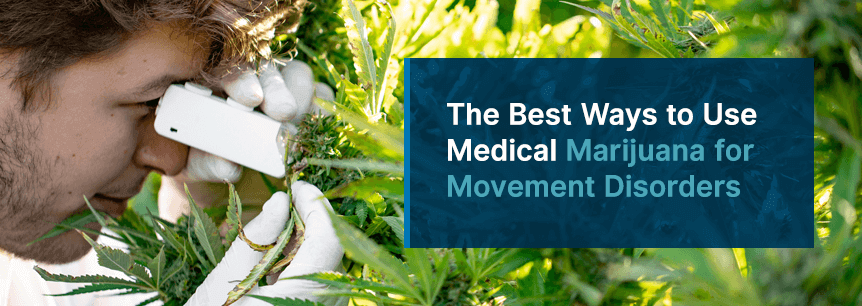
Marijuana for movement disorders is available in a variety of consumption methods. Despite its potential effects on the lungs, many patients prefer to smoke the herb because it provides them with instant effects. But, if you’re concerned about the possible respiratory system effects, why not try one of these methods:
A movement disorder is a neurological condition characteristically affecting the fluency, speed, ease, and quality of voluntary muscle movements. These could affect daily living activities or simple everyday tasks like walking and writing.
On top of this, there is a high prevalence of underrecognized and undertreated movement disorders.
Movement disorders might cover a large range of severity and, in many cases, can be disabling. Here are six common types of movement disorders.
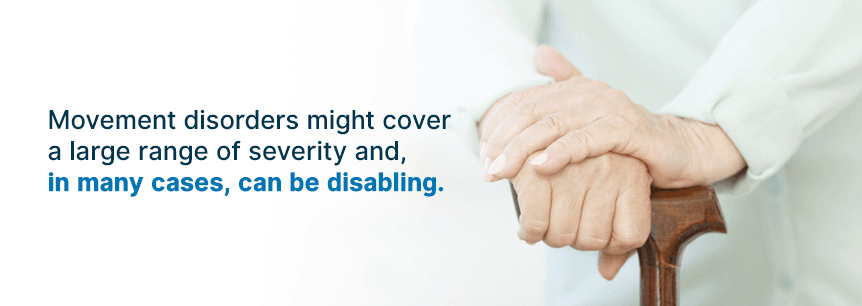
Ataxia is a degenerative condition that affects your spinal cord, brain, and brainstem. It includes two main types — Friedreich’s ataxia and Spinocerebellar Ataxia. The condition can lead to imbalance, inaccuracy, a lack of coordination when carrying out voluntary movements and instability. Your actions may appear jerky or disjointed. You might often fall due to an unsteady gait (i.e., unsteady walk). It can also affect the movement of your eyes and your speech.
Dystonia is a type of neurological muscle condition marked by involuntary muscle spasms that results from abnormal basal ganglia functioning. Your basal ganglia are the deep part of your brain, helping to control your coordination of movement. These areas of your brain control the fluidity and speed of movement and keep you from making unwanted movements. Individuals with this condition might experience repetitive movements, uncontrollable twisting or abnormal positions and postures.
These can impact any part of your body, including your legs, arms, vocal cords, trunk, and eyelids. General dystonias involve your whole body, while focal dystonias involve just one area of the body, typically the eyelids (blepharospasm), neck (spasmodic torticollis), hand (limb dystonia or writers’ cramp) or lower face (Meige syndrome). Depending on the area of your body affected, the disorder can be extremely disabling.
Essential tremor (ET) is a common movement disorder. It’s also referred to as familial tremor, benign essential tremor or hereditary tremor. Individuals with ET might experience uncontrollable tremor (shaking) in their head, voice, hands or other parts of the body. The condition typically starts as an adult and might become gradually worse with age.
A tremor is usually most noticeable during fine hand movements like using a spoon, holding a cup or writing or when your hands are outstretched. Tremors often stop if the arms or hands are completely relaxed like when you rest them in your lap. Stress frequently makes the tremor worse temporarily.
This is a progressive condition caused by nerve cell degeneration in the area of the brain known as the substantia nigra, which is responsible for controlling movement. The nerve cells become impaired or die, losing their ability to make dopamine, an important chemical. You may experience things like tremor or muscle rigidity with Parkinson’s disease.
Each year, around 60,000 new PD cases are diagnosed, according to the Parkinson’s Disease Foundation. This adds to the almost 10 million individuals worldwide with the disease. Although the risk of being diagnosed with Parkinson’s increases with age, around four percent of people burdened with the disease receive their diagnosis before the age of 50.
Spasticity is when you have increased muscle contractions that cause tightness or stiffness of the muscles that might interfere with speech, movement and walking. Damage to the part of the spinal cord or brain that controls voluntary movement can cause spasticity. Conditions like multiple sclerosis, spinal cord injury, stroke, severe head injury or cerebral palsy could also be a causal factor.
Parkinsonism is a group of disorders with symptoms similar to the symptoms of Parkinson’s disease. Parkinsonism’s defining feature is bradykinesia, or slowness with degradation and decrement of repetitive movements — similar to fatigue. The primary neurodegenerative cause of Parkinsonism is Parkinson’s disease. Progressive supranuclear palsy, multiple system atrophy, and corticobasal degeneration are other causes.
Some movement disorder causes include:
Symptoms you experience depend on the movement disorder you have. For instance, Parkinson’s produces various common symptoms such as:
It often causes things like:
Along with the physical symptoms of movement disorders, the disease might also cause depression, anxiety, and memory loss.
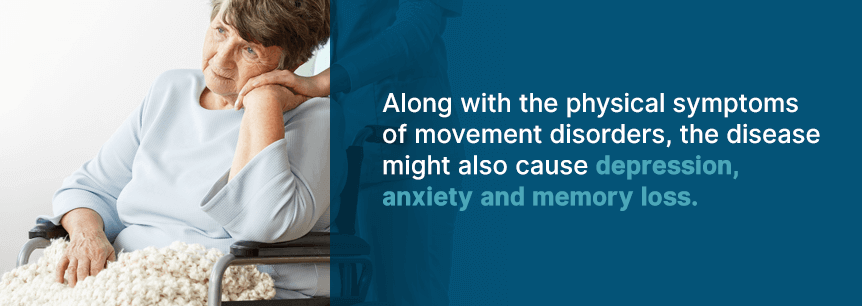
Again, complications you may experience depends on the movement disorder you have. For example, if you have Wilson’s disease, complications could include neurological and psychiatric problems and liver disease as a result of copper accumulating in your brain, liver, and other vital organs. You may experience vomiting of blood, jaundice, tremor, abdominal pain and swelling and difficulty talking, walking or swallowing.
Psychiatric complications could include aggression, depression and suicidal or homicidal behavior. When not treated, it could also cause death.
The treatment you receive will depend on which movement disorder you have. Here are five common treatment options patients with movement disorders have.
Medications are available for many movement disorders, including Parkinson’s, and can be very helpful. Some medicines for PD may include:
Both physical therapy and occupational therapy can help with movement disorders. Some examples of PT are:
For most individuals with movement disorders, cognitive, motor and behavioral impairments result in a loss of functional ability, leading to a loss of independence in daily living activities, thereby diminishing their quality of life. OT involves using contextually fitting functional activities for enhancing participation in roles in the workplace, at home, at school or in the community.
Doctors have used Botox therapy to treat disorders like spasticity, cerebral palsy and dystonia for many years because it relaxes the muscles.
This is a surgery an individual has when they have advanced dystonia, Parkinson’s disease, and other tremors. It’s like a pacemaker, except instead of for your heart, it’s for your brain. The implanted device sends your brain electrical stimulation for changing signaling in your brain, helping to relieve your symptoms.
There have been a few innovations over the past several years in the design of clinical trials evaluating new therapies for individuals with movement disorders. These include demonstrating disease-modifying effects, attempting to address difficulties in carrying out clinical trials in treated individuals in the progressed stages of their disease, evaluating the impact of interventions in individuals in the premanifest state of their illness and reducing cumulative disability development.
In order to find success using medical marijuana for movement disorders success, it’s important you find a good cannabis doctor and dispensary. Look no further for both than MarijuanaDoctors.com. We also have a friendly staff ready to help point you in the right direction of the marijuana delivery methods and products that will benefit you the most.
If you’re struggling with the tremors, muscle aches, and pains, depression or any of the other symptoms of movement disorders, you should give medical weed a try. Countless patients are pleased with its results, and you could be, too. Schedule your appointment today to get connected to a qualified medical marijuana doctor.
Find A Doctor Find A Dispensary